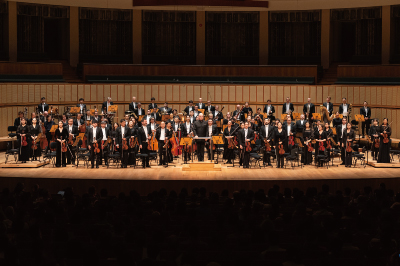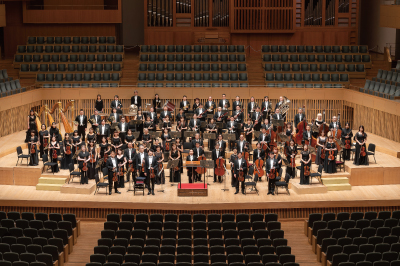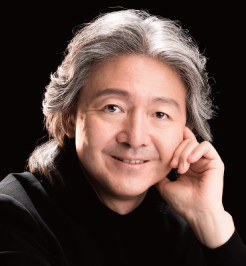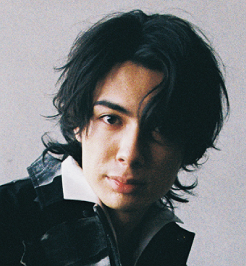Asia Orchestra Week 2024
Thank you for visiting ‘Asia Orchestra Week 2024.’
The Agency for Cultural Affairs (ACA) National Arts Festival has presented outstanding works of art from Japan and abroad to a broad public segment since 1946.
For a series of orchestral concerts, ‘Asia Orchestra Week’ since 2002 invites professional orchestras of the Asia-Pacific region.
So far, 60 orchestras from 16 countries and regions have joined the AOW to give colorful, passionate sounds of their own.
The year 2024 was the first year of holding the AOW in Kyoto! Please enjoy the rich sounds of each orchestra to your heart’s content.
※Some programs are not included in YouTube distribution.
Performance
-
Oct. 19 Sat. 16:00(15:15 Opening)
Kyoto Concert HallSingapore Symphony Orchestra
-
Oct. 22 Tue. 19:00(18:15 Opening)
Kyoto Concert HallCity of Kyoto Symphony Orchestra
Program Notes
Mendelssohn: A Midsummer Night's Dream Overture, op. 21
Singapore Symphony Orchestra, Hans Graf, Conductor, Hélène Grimaud, Piano
Oct. 19 Tue. Live recording Venue: Kyoto Concert Hall
Felix Mendelssohn (1809 – 1847), a German composer and a key figure of the early Romantic period, is celebrated for his buoyant melodies and sacred, transparent resonance. Recognized as a prodigy from a young age, his music is known for its brightness and elegance. Born into a wealthy family, with his father being a banker, Felix grew up alongside his sister, Fanny, without any hardships. However, his Jewish heritage brought about irrational challenges in Europe at the time. Although Mendelssohn converted to Christianity at his father’s urging and managed to establish his social standing, he still faced deep-rooted discrimination for many years.
The Overture to A Midsummer Night’s Dream was composed in 1826 when Mendelssohn was 17 years of age, inspired by Shakespeare’s play of the same name. He wrote it voluntarily and later arranged it for piano four hands to share the joy of the fairy world with his sister, Fanny. King Friedrich Wilhelm IV of Prussia, greatly impressed by this overture, commissioned Mendelssohn to compose incidental music for the entire play. In Japan, the play’s title has been translated literally by Tsubouchi Shoyo and others. Although both the original and translated titles use the term “midsummer,” the story is actually set around the summer solstice.
The Overture is brimming with refreshing sounds. It begins with four distinct chords played by woodwinds and horns, inviting the audience into the story. Rapidly moving violins that follow evoke a “sense of anticipation.” With two more entries by the winds, the music bursts into life and continues forward.
Ravel: Piano Concerto in G major
Singapore Symphony Orchestra, Hans Graf, Conductor, Hélène Grimaud, Piano
Oct. 19 Tue. Venue: Kyoto Concert Hall
All the works of Maurice Ravel (1875 – 1937), a French modernist composer, share a delicacy akin to fine glasswork and perfection that seems almost inevitable, as though they could be nothing else. Igor Stravinsky once compared Ravel to a “Swiss watchmaker.” Indeed, the distinct and intricately woven threads of sound create a uniquely cool atmosphere in his music.
Ravel composed two piano concertos: this one in G Major, and the other, Piano Concerto for the Left Hand in D Major. Both were late works, conceived almost simultaneously. Piano Concerto in G Major, which Ravel himself described as a “piano concerto not exclusively for the right hand,” was written between 1929 and 1931 when he was 56 years of age. It premiered on January 14, 1932, at Salle Pleyel in Paris, with Orchestre Lamoureux under the composer’s direction and pianist Marguerite Long, a great interpreter of Ravel’s music. By that time, Ravel was a prominent figure in the French music scene, though his health had begun to deteriorate.
The concerto consists of three movements. The 1st movement commences with an impressive crack of a whip, signaling the start of lively music, which bursts forth like an overturned toy box. Jazz influences are strong throughout, with the distinctive timbre of blue notes shifting freely in expression. The 2nd movement flows with sheer beauty, embodying a quintessentially French style of the time, something only Ravel could have created. The 3rd movement races ahead with an unrelenting energy. Full of virtuosity, it unfolds in vivid music, with every instrument giving its all, leading to a refreshing finale. Interestingly enough, a phrase resembling the theme from the Japanese film Godzilla appears, which could be interpreted as an unconscious homage by Ifukube Akira, the score’s composer and an admirer of Ravel.
Koh Cheng Jin: Luciola singapura
Singapore Symphony Orchestra, Hans Graf, Conductor, Hélène Grimaud, Piano
Oct. 19 Tue. Live recording Venue: Kyoto Concert Hall
Commissioned by the Singapore Symphony Orchestra for Singapore’s 56th birthday concert in 2021, Luciola singapura commemorates the major discovery of a new species of firefly that same year, the first since 1909, made by researchers from Singapore’s Lee Kong Chian Natural History Museum.
The Luciola singapura or Singapore Firefly, located in the Nee Soon Swamp Forest – Singapore’s last remaining freshwater swamp forest – is genetically and morphologically distinct from other species, hence deserving of its name. It has a beautiful, shimmery golden appearance, a sight truly unforgettable once beheld. With the colourful addition of the yangqin (Chinese dulcimer), an instrument special to my musical upbringing, the music strives to evoke the mysterious allure and animated vitality of this wondrous, luminous creature. Chinese music gestures can also be heard dispersedly, combined with long melodic lines and fresh harmonies. Beyond the fusion of musical cultures and science, the work expresses the desire to celebrate all things uniquely Singaporean. It is my hope that the work serves as a timely reminder for the preservation of endangered species and core habitats in the face of ceaseless modernisation and climate change.
Programme note by the composer, Koh Cheng Jin
Beethoven: Symphony No. 5 in C minor, op. 67
Singapore Symphony Orchestra, Hans Graf, Conductor, Hélène Grimaud, Piano
Oct. 19 Tue. Live recording Venue: Kyoto Concert Hall
Perhaps the most famed symphony ever performed by any orchestra is Ludwig van Beethoven’s (1770 – 1827) Symphony No. 5, known in Japan as the “Fate Symphony.” However, the story of Beethoven supposedly saying, “Thus fate knocks at the door,” which led to the title, is said to be a fabrication. The “fate motif” at the beginning is a theme that everyone recognizes as the symbol of this piece. This motif expressed as “ja-ja-ja-jahn” in Japan and “ta-ta-ta-taa” in Europe serves as the foundation for the entire work. It’s no exaggeration to claim that the entire piece is constructed from these four notes.
The dynamic and relentless energy of Symphony No. 5 epitomizes Beethoven’s style. He began composing it in 1807 and completed it early in 1808 when he was 38 years of age. It premiered on December 22 of that year along with Symphony No. 6 “Pastoral”. This was the period when Beethoven had relocated from his hometown of Bonn to Vienna and was enjoying a prolific phase in his life.
The symphony consists of four movements. In the 1st movement, the four-note “fate motif” is repeated many times, generating the music as solid as an architectural structure. Even in the relatively calm 2nd movement, the cleverly placed “fate motif” is highly effective, forming a set of variations. The 3rd movement begins in an eerie, creeping manner. In the transitional section leading seamlessly to the 4th movement, energy is accumulated, and the explosion at the beginning marks the start of the climax. Beethoven’s innovative structure, which brings the climax of an entire work to the final movement, produces a stunning effect in Symphony No. 5, culminating in a triumphant and glorious conclusion.
Komibuchi Hikoyuki
Musicologist, Music Critic
Ifukube Akira: Symphonic Fantasia No. 1
City of Kyoto Symphony Orchestra, Otomo Naoto, Conductor, LEO, Koto
Oct. 22 Tue. Live recording Venue: Kyoto Concert Hall
The music of Ifukube Akira (1914 – 2006) is inseparable from his birthplace, Hokkaido. Born in Kushiro and raised in the town of Otofuke in Tokachi, the folk songs sung by settlers and the Ainu tunes in this region became the foundation for his later compositions. His rich and imaginative music is filled with originality that evokes a sense of eternal expanse. Ifukube, like other Japanese composers of his generation, wrote a significant amount of film music, totaling over 300 scores. Among these, his most notable contribution remains the music for Godzilla.
The three pieces of Symphonic Fantasia, including No. 1, which will be presented today, premiered on August 5, 1983, at Tokyo Metropolitan Hibiya Public Hall. The concert titled “Ifukube Akira: An Evening of SF Special Effects Film Music” was performed by Tokyo Symphony Orchestra with Shiozawa Yasuhiko conducting. Initially, Ifukube was reportedly hesitant to include film music in a concert setting but was eventually persuaded by the enthusiasm of those around him and gave in.
Symphonic Fantasia No. 1 commences with the “Godzilla motif.” After the bridge, a rich variety of pieces in different tempi are presented from six films; Theme from Godzilla, Theme from King Kong vs. Godzilla, Night Music from Battle in Outer Space, Horreur Music from Frankenstein Conquers the World, “Godzilla and Rodan” from Ghidorah, the Three-Headed Monster, Theme from Battle in Outer Space, Theme from Destroy All Monsters, and Fighting Music from Battle in Outer Space.
Miyagi Michio=Ikebe Shin-ichiro: Haru no Umi (The Sea in Springtime) for Orchestra
City of Kyoto Symphony Orchestra, Otomo Naoto, Conductor, LEO, Koto
Oct. 22 Tue. Live recording Venue: Kyoto Concert Hall
Miyagi Michio (1894 – 1965) incorporated elements of Western music into the traditional world of koto music, creating a new Japanese sound under the banner of the “New Japanese Music Movement.” He was a pioneer who opened new horizons in traditional Japanese music. Haru no Umi, originally written for koto and shakuhachi, was published in 1929 when Miyagi was 35 years of age and became his signature piece. It has become established as a New Year’s tune as its premiere was broadcast by a Hiroshima radio station on January 2, 1930. The piece was based on “Rock by the Seashore,” the theme of the Imperial New Year poetry reading. Miyagi commented, “The model for the piece is the islands of the Seto Inland Sea, with sounds of peaceful waves, oars rowing boats, and chirping birds.”
Commissioned by NHK in 1980, Ikebe Shinichiro (1943 – ) arranged it for solo koto and orchestra. It premiered at the 26th NHKSO Golden Pops Concert on January 7, 1981, with NHK Symphony orchestra, conductor Mori Tadashi, and koto soloist Yuize Shunichi. This concert featured other works based on Japanese music, including Toyama Yuzo’s Rhapsody for Orchestra and Koyama Kiyoshige’s Kobiki-Uta for Orchestra.
Konno Leo: Matsukaze (strings arrangement by Iga Takuro)
City of Kyoto Symphony Orchestra, Otomo Naoto, Conductor, LEO, Koto
Oct. 22 Tue. Live recording Venue: Kyoto Concert Hall
I wrote this piece for MBS’s OTOBUTAI, held in 2022 at Nijo Castle in Kyoto. Nijo Castle is renowned for its pine tree wall paintings. In this composition, “Matsu” (Pine) symbolizes timeless universality, while “Kaze” (Wind) represents the passage of time and change. I aimed to express the contrast through the music. For the premiere, dancer Tanaka Min also performed.
The piece sets out with a classical “koto-like” phrase, with the instrument tuned almost the same way as in Miyagi Michio’s Haru no Umi. It then transitions into a “less-koto-like” middle section, where the same motif develops but is marked by leaping phrases and irregular times. Ultimately, it is structured to return to the theme introduced at the very beginning.
I started teaching myself composition as a high schooler but had never consciously focused on “koto-like” elements, instead drawing inspiration from the music I loved and my daily life. It may be that I distanced myself from tradition. However, for Matsukaze, to be performed at Nijo Castle, I intentionally incorporated classical motifs and koto-like sounds for the first time. This piece was my turning point, allowing me to engage with the classical spirit and Japanese music that I had been learning through the koto.
Today, we will perform the version arranged by Iga Takuro, who added strings to the original. I am truly delighted to present this piece to the audience in Kyoto, where it premiered.
Programme note by the composer, Konno Leo
Brahms: Symphony No. 1 in C minor, op. 68
City of Kyoto Symphony Orchestra, Otomo Naoto, Conductor, LEO, Koto
Oct. 22 Tue. Live recording Venue: Kyoto Concert Hall
Johannes Brahms (1833 – 1897) composed four symphonies, all of which have been repeatedly performed by orchestras around the world as staples of their repertoire. Each symphony presents its own distinct style and is widely recognized as a masterpiece.
Symphony No. 1, featured today, was completed in the fall of 1876 in Lichtenthal, Baden-Baden, near Vienna when Brahms was 43 years of age. It premiered on November 4 of the same year, performed by Hof-Capelle Carlsruhe under the direction of Otto Dessoff. Soon after, the work was heard across Europe, quickly gaining popularity among audiences.
By this time, Brahms had already established a significant career. However, there was a reason he had to wait until after turning 40 to complete this symphony. Composers of the era faced a common challenge: what kind of music could they write in the shadow of the monumental legacy of Beethoven’s nine symphonies? Brahms had long harbored the idea of writing a symphony, starting as early as 1855, but the progress stalled. He wrote the initial draft of the 1st movement in 1862 and even played it on the piano for Clara Schumann. It was only in 1876 that he resumed the project in earnest and completed the symphony.
The work is in four movements. Brahms took great deliberation before finalizing how to open the piece. The emphatic timpani strikes in the extended introductory melody make a definitive presence and a hallmark of the symphony. The 1st movement is structured with suffocating tightness, its layers of sound conveying a robust character. In contrast, the 2nd movement shifts to a softer, more lyrical tone. The theme is introduced by the oboe, passed to the solo violin of the concertmaster, and finally to the horn, much like a concerto. The 3rd movement offers a sheer pastorale with chamber music-like intimacy. The 4th movement is one of the most dramatic ever created. Brahms’s intense enthusiasm becomes fully evident as the leisurely flow of melody builds to an unstoppable elation, culminating in a grand finale.
Komibuchi Hiroyuki
Musicologist, Music Critic
Profile
-
Singapore Symphony Orchestra
Established in 1979, the Singapore Symphony Orchestra is dedicated not only to subscription concerts but also to music education for Singaporean youth. In 2021, it was awarded the 3rd place in “Orchestra of the Year” by Gramophone, a UK magazine, and was ranked among the world’s best orchestras by BBC Music Magazine the following year. Hans Graf was appointed 3rd Music Director. The orchestra made its debut at the 120th BBC Proms in London in 2014, receiving high praise from UK dailies, the Guardian and the Telegraph. In May 2016, it performed at the Dresden Music Festival and the Prague Spring International Music Festival. For the 2024/25 season, the orchestra plans performances at the Asia Orchestra Week in Kyoto and a three-city tour in Australia.
Official site
©Singapore Symphony and Aloysius Lim
-
Hans Graf, Conductor
Austrian-born Hans Graf became Music Director of the Singapore Symphony Orchestra in 2022. He has previously held the position of Music Director with the Houston Symphony, the Calgary Philharmonic Orchestra, Orchestre National Bordeaux Aquitaine, the Basque National Orchestra, and Mozarteum Orchester Salzburg. Graf has collaborated with numerous prestigious orchestras in Europe and North America, as well as participating in various music festivals and opera houses. He is known for his extensive repertoire and innovative programming.

©Singapore Symphony and Bryan van der Beek
-
Hélène Grimaud, Piano
French pianist, Hélène Grimaud entered Conservatoire de Paris at the early age of thirteen and won the 1st prize in piano performance three years later. In 1987, she was invited by Daniel Barenboim to perform with Orchestre de Paris, and she has since performed repeatedly with major orchestras worldwide. She has been an exclusive artist with Deutsche Grammophon since 2002. Aside from her music, Grimaud is also known for her environmental activities dedicated to the conservation of endangered wolves.

©Mat Hennek
-
City of Kyoto Symphony Orchestra
Founded in 1956, the City of Kyoto Symphony Orchestra is the only orchestra in Japan established and operated by a local government. In 2015, along with Hirokami Junichi, it won the 46th Suntory Music Award and had a successful European tour in June of the same year. The orchestra received several prizes at the 37th Music Critics Club Award in 2017. Okisawa Nodoka became the 14th Chief Conductor in April 2023, and Jan Willem de Vriend took the role of Principal Guest Conductor starting in April 2024. The orchestra aims to further its reputation as a world-class ensemble representing the cultural and artistic city of Kyoto.
Official site
©井上写真事務所 井上嘉和
-
Otomo Naoto, Conductor
Otomo Naoto made his debut conducting the NHK Symphony Orchestra while studying at the Toho Gakuen School of Music. He has held positions as Principal Conductor/Music Director of the Japan Philharmonic Orchestra, the Osaka Philharmonic Orchestra, and the Tokyo Symphony Orchestra, Chief Conductor of the City of Kyoto Symphony Orchestra, and Music Director of the Gunma Symphony Orchestra. Currently, he is Honorary Guest Conductor of the Tokyo Symphony Orchestra, Conductor Laureate of the City of Kyoto Symphony Orchestra, Music Director of the Ryukyu Symphony Orchestra, and Artistic Director of the Takasaki City Theatre. Otomo also serves as Professor at the Osaka University of Arts, Specially Appointed Professor at the Toho College of Music, and Visiting Professor at the Kyoto City University of Arts and the Senzoku Gakuen College of Music.

©Rowland Kirishima
-
LEO, Koto
Born in 1998, LEO won the Japanese Hogaku Music Competition in Kumamoto at the age of sixteen, becoming the youngest winner in its history. He has performed with renowned conductors such as Sebastian Weigle, Michiyoshi Inoue, Masato Suzuki, and Kazuyoshi Akiyama, and with orchestras including the Yomiuri Nippon Symphony Orchestra, the Tokyo Philharmonic Orchestra, and the City of Kyoto Symphony Orchestra. He has appeared on television programs like “Jounetsu-Tairiku,” “Untitled Concert,” and “Tetsuko-no-Heya.” LEO was the first koto player to give a live concert at Blue Note Tokyo. He also garnered attention for his performance at the Summer Sonic.

©Nippon Columbia